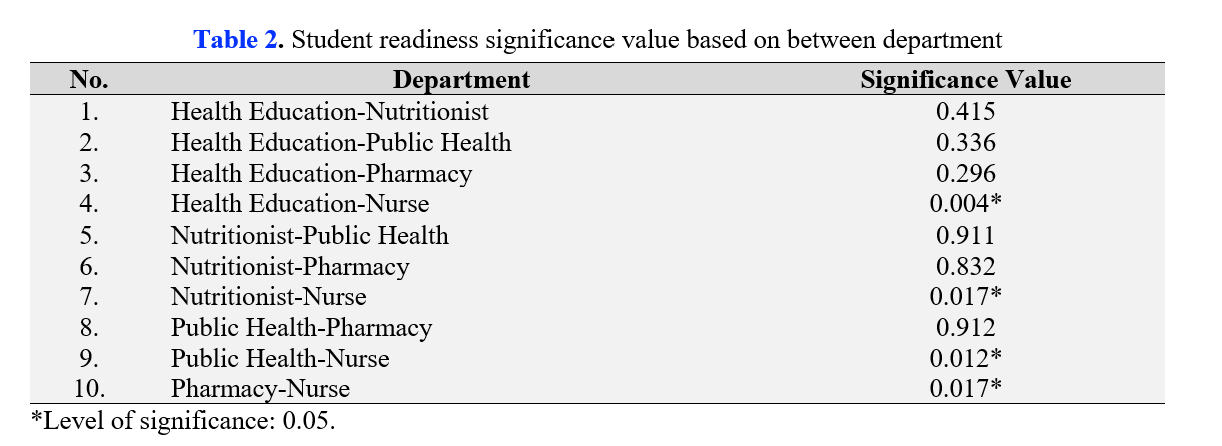Main Article Content
Abstract
The implementation of interprofessional education (IPE) into higher education curricula is a significant method for creating professionals with the skills necessary for interprofessional collaboration (IPC), including those in the health sciences, nursing, pharmacy, and nutrition. Due to the changes in health services, which are becoming more integrated, it is vital to have the capacity for interprofessional collaboration. The readiness of the pupils for IPE must be assessed before to its implementation in order to identify the subjects that should be highlighted at that time. This research is a cross-sectional study using descriptive analysis method. The distribution of respondents was as all in 4th semester students, consist of department of Pharmacy (n=92), department of Nursing (n=88), department of Public Health (n=95), department of Nutrition (n=66) and department of Physical Education (n=42) in Faculty of Health Sciences. Questionnaire data collection was carried out online. The independent variable that is measured is the student's readiness for Interprofessional Education. The results findings there is a significant difference between the readiness of students in Nurse department and students of all department. The nurse department received the highest score (score = 68.47) and the Health Education received the lowest score (score = 65.59). But all department receive score > 80% of the total score. There is still room for improvement in the areas related to the value of learning together in practical situations
Keywords
Article Details

This work is licensed under a Creative Commons Attribution-NonCommercial 4.0 International License.
References
- Alruwaili, A., Mumenah, N., Alharthy, N., & Othman, F. (2020). Students’ readiness for and perception of Interprofessional learning: A cross-sectional study. BMC Medical Education, 20(1), 390. https://doi.org/10.1186/s12909-020-02325-9
- Bridges, DianeR., Davidson, R. A., Soule Odegard, P., Maki, I. V., & Tomkowiak, J. (2011). Interprofessional collaboration: Three best practice models of interprofessional education. Medical Education Online, 16(1), 6035. https://doi.org/10.3402/meo.v16i0.6035
- D’Costa, M. P., Jahan, F., & Al Shidi, A. (2022). Health professions students’ attitude, perception, and readiness toward interprofessional education and practice in Oman. Journal of Taibah University Medical Sciences, 17(2), 248–255. https://doi.org/10.1016/j.jtumed.2021.10.004
- Febriana, B. (2019). Kesiapan Dan Persepsi Mahasiswa Keperawatan Pada Program Ipe: Studi Pada SGD Dengan LBM Jiwa. Jurnal Keperawatan Jiwa, 7(1), 101. https://doi.org/10.26714/jkj.7.1.2019.101-106
- FIKES. (2021). Buku Pedoman Akademik Fakuktas Ilmu-ilmu Kesehatan (FIKES) tahun 2021-2022 Universitas Jenderal Soedirman. FIKES UNSOED.
- Gilbert, J. H. V., Yan, J., & Hoffman, S. J. (2010). A WHO Report: Framework for Action on Interprofessional Education and Collaborative Practice. Journal of Allied Health, 39(3), 196–97.
- Guraya, S. Y., & Barr, H. (2018). The effectiveness of interprofessional education in healthcare: A systematic review and meta-analysis. The Kaohsiung Journal of Medical Sciences, 34(3), 160–165. https://doi.org/10.1016/j.kjms.2017.12.009
- Huebner, S., Tang, Q. C., Moisey, L., Shevchuk, Y., & Mansell, H. (2020). Establishing a baseline of interprofessional education perceptions in first year health science students. Journal of Interprofessional Care, 35(3), 400–408. https://doi.org/10.1080/13561820.2020.1729706
- International Pharmaceutical Federation (FIP), (2015). Interprofessional education in a pharmacy context: Global report. International Pharmaceutical Federation.
- Maharajan, M. K., Rajiah, K., Khoo, S. P., Chellappan, D. K., De Alwis, R., Chui, H. C., Tan, L. L., Tan, Y. N., & Lau, S. Y. (2017). Attitudes and Readiness of Students of Healthcare Professions towards Interprofessional Learning. PloS One, 12(1), e0168863. https://doi.org/10.1371/journal.pone.0168863
- Mobalen, O., Faidiban, R. H., & Parlaungan, J. (2021). Interprofessional Education (Ipe) Dalam Meningkatkan Persepsi Dan Kesiapan Kolaborasi Mahasiswa. Jurnal Ilmu Keperawatan Jiwa, 4(3), 495–500.
- Nelson, S., White, C., Hodges, B., & Tassone, M. (2017). Interprofessional Team Training at the Prelicensure Level: A Review of the Literature. Academic Medicine, Vol. 92(5), 709–716. https://doi.org/10.1097/ACM.0000000000001435
- O’Donoghue, G., & Cusack, T. (2012). The introduction of an interprofessional education module: Students’ perceptions. Qual Prim Care. 2012;20(3):231–8. Quality in Primary Care, 20(3), 231–238.
- Rasmita, D., Timiyatun, E., & Pramitaresti, I. G. A. (2018). Gambaran persepsi dan kesiapan mahasiswa terhadap implementasi ipe (interprofessional education) di stikes surya global yogyakarta. Jurnal Keperawatan Priority, 1(2), 28–37.
- Reeves, S., Perrier, L., Goldman, J., Freeth, D., & Zwarenstein, M. (2013). Interprofessional education: Effects on professional practice and healthcare outcomes. Cochrane Database of Systematic Reviews, Issue 3. https://doi.org/10.1002/14651858.CD002213.pub3.
- The Canadian Interprofessional Health Collaborative. (2010). A National Interprofessional Competency Framework. University of British Columbia.
- Tyastuti, D., Onishi, H., Ekayanti, F., & Kitamura, K. (2014). Psychometric item analysis and validation of the Indonesian version of the Readiness for Interprofessional Learning Scale (RIPLS). Journal of Interprofessional Care, 28(5), 426–432. https://doi.org/10.3109/13561820.2014.907778
- WHO. (2010). Framework for Action on Interprofessional Education & Collaborative Practice. http://www.who.int/hrh/nursing_midwifery/en/
- Yune, S. J., Park, K. H., Min, Y. H., & Ji, E. (2020). Perceptions of the interprofessional education of the faculty and the level of interprofessional education competence of the students perceived by the faculty: A comparative study of medicine, nursing, and pharmacy. Korean Journal of Medical Education, 32(1), 23–33. https://doi.org/10.3946/kjme.2020.150
